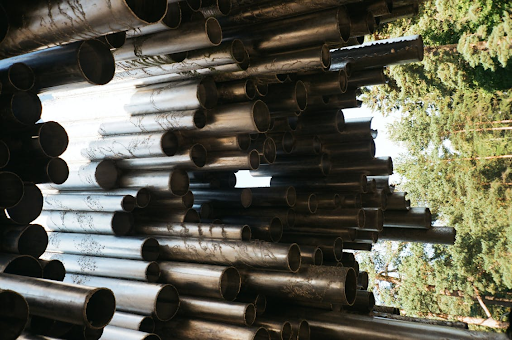It’s critical to select the appropriate pipe for any redesign, remodeling, or repair project. There isn’t such thing as a universal solution in pipes. Presently, several various types of plumbing pipes are extensively utilized, each with its own set of benefits and drawbacks in diverse uses. This article will be going through the different types of pipes and their right application in plumbing.
Table of Contents
1. Stainless Steel Pipes
Stainless steel may appear to be quite elegant, but it is extremely costly. Stainless steel pipe is utilized in regions where corrosion is a problem, such as along the ocean. This sort of pipe comes in both flexible and rigid versions, and it will require special couplings to connect to other pipes. Stainless steel pipes come in a variety of sizes and lengths.
2. Copper Pipes
Copper pipes are the most common type of plumbing pipe because of their long lifespan and dependability. They offer exceptional corrosion resistance, are a wonderful material for both hot and cold water, and are simple to maintain. The most essential thing to keep in mind before utilizing copper pipe is that it must be soldered together and may require extra fittings. Talk to a plumber if you don’t know how to solder copper pipes.
3. PVC Pipes
PVC pipes provide cold and hot clean water. They are also used in sewages. PVC pipes come in a variety of thicknesses and configurations, based on their use. Pressure water pipes, for instance, are neither the same as sewer pipes nor are they the same as those used in storm drainage systems. Plastic plumbing goods intended for potable water applications are normally labeled with either NSF-PW or NSF-61 to indicate that they meet the health impact criteria.
4. Galvanized Pipes.
Galvanized pipes were the initial industry standard for residential installations. Unfortunately, due to rust forming inside tiny diameter pipes, they have become less popular in home settings over time. If the pipe is old enough, you may notice rust traces in the water flowing from the faucet, as scales can break off from the interior of the pipe. Greywater and non-potable water may both be transported using galvanized pipes.
5. Brass Pipes
If brass plumbing pipes are 67 percent to 85 percent copper, they have excellent rust tolerance. Red brass pipe is the best brass pipe grade, which is created when the alloy includes 85 percent copper. Brass piping is a durable material that does not corrode on the inside and does not produce internal friction drag.
Brass plumbing pipes are simpler to thread than steel pipes, making them ideal for hot-water and large-scale distribution systems like pump fittings, water tanks, and wells. Brass pipe is known for being one of the most durable plumbing materials. Linear lengths of brass pipe up to 12 feet are available in TUBOMART plumbing.
6. Cast Iron Pipes
Bell-and-spigot cast iron plumbing pipes are the most common form. There are also threaded joints available, which are more costly than the bell and spigot alternative. Large structures and subterranean areas frequently employ bell and spigot cast iron.
Another form of cast iron plumbing pipe that is extensively used is no-hub cast iron: The pipes and fittings of this kind are joined by couplings produced by a variety of producers that provide varied band strengths for diverse applications.
Cast iron pipes are bulkier than other pipes and are typically utilized in water distribution systems or as the primary pipe in drainage or sewage systems that are installed subsurface. The bell and spigot piping is constructed in sizes ranging from 2 to 15 inches, the minimum size that is generally manufactured in the 4-inch pipe, which is big enough to be utilized in household applications. Because the cast iron pipe is heavy, it must be sustained while being assembled.
7. PEX Pipes
PEX pipe is a type of flexible plastic piping that has grown popular in both residential and commercial uses. Even though it has a slightly high capital cost, it is the best pipe for water distribution within a building due to its low upkeep and quick installation procedure.
PEX pipe is a leak-proof material that has advantages over copper plumbing. One of the most significant disadvantages is that it cannot be used outdoors due to UV radiation damaging the external plastic covering.
The Bottom Line
Whether you’re replacing existing pipes or installing new ones, it’s critical to check local building rules to ensure that you’re using materials that are legal in your location. Consulting a specialist could also be the smart thing if you want to get quality pipes.
https://www.

